Some television comedies are simply funnier than everything else around; others daringly ahead of their time. The Good Life, which first appeared on our screens half a century ago, was both. It was about love, friendship and loyalty, and about living off the land – even if that land was your own garden, in a humdrum corner of suburbia.
“Though it seemed to be very light, and in fact was very light, it was actually dealing with some fundamentally important issues,” says star Felicity Kendal. “It foresaw this global change where people were no longer thinking that the only important thing in life was to have a job, a mortgage and a pension, and just things in general, but that getting a chicken to lay an egg in your own back yard could bring even greater satisfaction. It was about living in the moment, I think, and it touched a nerve. Rather wonderfully, it still does.”
The Good Life was lovely, funny and beautifully acted. Set in Surbiton, on the very edges of south-west London, it revolved around two sets of neighbours: Tom and Barbara Good (played by Richard Briers and Kendal) and Margo and Jerry Leadbetter (Penelope Keith and Paul Eddington). Tom and Jerry worked together in advertising, where the former was less invested in climbing the corporate ladder than the latter, while Barbara and Margo were their respective faithful housewives. Barbara liked to get her hands dirty in the garden; Margo was more concerned with the latest fashion styles delivered direct to her door from Harrods, and was unafraid to challenge the local council if her drains weren’t cleaned in a timely fashion.

Both couples – each curiously child-free, something no character ever commented on – spent a lot of their downtime in one another’s company. Their on-screen chemistry was exquisite, and when Tom’s home-brewed peapod wine was flowing, certain overtures were made towards that purportedly overriding preoccupation amongst married couples in the 70s: wife-swapping.
That chemistry was entirely genuine, according to Kendal, now 79, whom I speak to ahead of The Good Life: Inside Out, a new celebration of the comedy tonight on U&Gold. “Oh, our friendship was incredibly loving. Penny and I knew each other well from the theatre, where she was always very robust while I was all over the place, and Dickie and Paul would always be taking the mickey. It was a great combination. And when things got a little silly buggers, Penny would pull us back.”
The show was written by TV veterans Bob Larbey and John Esmonde primarily as a vehicle for Briers, then the most famous of the quartet. “Dickie,” Kendal says of her on-screen husband, “was the one who wanted to do it. He loved the script, but it was on this tiny budget, with a tiny little set, and not expensive at all, except for Dickie’s fee; the rest of us were all on pennies. But we were just happy to be on the BBC.” There were little expectations for it, initially. “We had no idea if it was going to work, to be honest.”
The first episode, screened on BBC One in 1975, saw Tom mired in a midlife crisis. He had just turned 40 and, swayed by the hippy ideals of the time, had presumptuously decided to jack in the day job in favour of living self-sufficiently. He and Barbara would grow their own vegetables, make their own clothes, and generate their own electricity. They might get some chickens and a goat, later on, a pig. Margo of course was horrified, and inevitably so: this was suburbia, after all. What on earth would the neighbours think?

It got off to a slow start, pulling in an average of five million viewers per episode at a time when up to 15 million people would watch any old slop the BBC and ITV offered up. But the second series was greeted with much more enthusiasm: 17 million tuned in. By the end of its fourth and (almost) final outing in 1977, it was universally loved. Even the Queen declared herself a fan – and, as we shall see, proved a somewhat demanding one.
Samira Ahmed, presenter of the BBC Radio 4 show Front Row, was similarly admiring. “Oh, I thought it was genius,” she says. Ahmed, who co-hosts a podcast entitled Through the Square Window which looks back at TV classics, believes the show has endured for so long because it contained hidden depths.
“When I was young, I watched it for the jokes, the slapstick, the gardening and the pigs. It was only later that I picked up on other things. Like the fact that it dared to show suburbia as quite a lonely place, and that there might be a deep sadness at the heart of Margo. And then there were the sexual politics, the idea of class, and the fact that opting out of the rat race was a viable option. These were big ideas that, in the 70s, the entire country was grappling with.”
While it revelled in a certain Englishness – television had no greater social climber, or curtain-twitcher, than Margo Leadbetter – it also pushed against stereotype.
“In 1970s sitcoms, women tended to be the secondary characters,” Ahmed says, “but here they were far more engaging and entertaining than their male counterparts. This was unusual for an era where women were encouraged not to make a fuss, to look away, and avoid embarrassment. Margo was the very opposite of this. She’d challenge people, and would hold anybody’s gaze, unafraid. She was imperious. And, consequently, she was incredibly inspiring.”

But the show has recently come in for a different kind of scrutiny. Viewed through a modern lens, Tom Good might just be an example of toxic masculinity, the belligerent alpha who could only ever see one point of view – his own – which his wife had dutifully to fall in line with. Richard Briers himself, who died in 2010, seemed to agree. “I never liked Tom,” he once said. “I thought he was a bully, and an obsessive.”
When I bring this up with Kendal, she groans. “I think that sometimes these days, because the show has endured for so long and become part of the folklore, people look back on it mistakenly, and slightly narrow-mindedly.” She is choosing her words here with necessary care. “It wasn’t a documentary, it was a comedy, and Tom did not drag Barbara along unwillingly. Barbara was positive, and practical, and totally in love with her partner. Yes, she got pissed off on occasion, but she loved Tom. I loved Tom.”
The show came to an end in 1977 after just four series. “We did like the idea of perhaps revisiting it at some point,” Kendal says, “but not after Paul died.” Eddington died in 1995, aged 68. “I think it shows you just how close we were that we couldn’t even consider doing it again without him.” (Penelope Keith, incidentally, is still very much with us. She appears in the new documentary, waltzing elegantly down memory lane. At 85, she remains magnificent.)
If, back in 1977, the show’s 17 million viewers registered their disappointment at its end, then so too did the incumbent monarch. The following year, the BBC received a letter from Buckingham Palace suggesting that the Queen, who had long wanted to be part of the studio audience during filming, might be available now should they grant her an encore. This being a time when there was more deference shown towards the royals than there is now, the cast was duly reassembled for a one-off Royal Command Performance episode in 1978.
“Oh, it was a thrilling experience,” Kendal recalls. Was she nervous, I wonder? “No, not really. We were used to filming in front of an audience. But we were worried about what we would do if something went wrong during the recording.” Whenever this did happen during filming – a regular occurrence, she says – “we tended to swear a bit, but I don’t think any of us wanted to swear in front of the Queen”. In the event, each upped their game accordingly. No fluffs.
“Which was a relief,” Kendal notes.
A couple of years after its demise, comedy reinvented itself, as comedy tends to do. It became “alternative”, more political; right-on. There were new household names now: Alexei Sayle, Ben Elton, Dawn French, Jennifer Saunders. One of the breakout hits was The Young Ones (1982-1984), starring Rik Mayall, Adrian Edmondson and Nigel Planer as disharmonious flatmates whose close proximity to one another often resulted in fists through walls, a cricket bat to the head, and cursory arson. Edmondson said that the aim of the show was “to do horrible characters as an antidote to [another popular 70s sitcom] Terry and June and The Good Life.”
That objective was largely achieved, for few would watch Terry and June, or others of a similar ilk, with quite the same willingness again.
But one programme endured, as Edmondson himself would later note. “The Good Life stands up better [than The Young Ones],” he said recently. “I’d rather watch that.”
Felicity Kendal went on to have a glittering career across television and theatre, but for some – in fact, for many – she will always be Barbara Good, early adopter of sustainable living, acutely aware of her carbon footprint, and someone who looked fabulous in a pair of dungarees.
She giggles. “Dungarees? Goodness, I haven’t worn those in, oh, at least 50 years.”
‘The Good Life: Inside Out’ is on U&Gold tonight at 9pm. ‘The Good Life’ is available to stream on BBC iPlayer
